Chinese Calligraphy
General Introduction
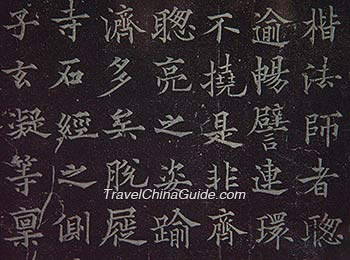 |
Ancient people paid great attention to calligraphy. It was the essential whereby a candidate could manifest his literary talent in the Imperial Examination, for it gave a first impression to the examiners. Children of high officials had to learn and try to write a good hand; even emperors themselves were good at calligraphy, for example, the versatile Emperor Qianlong in the Qing Dynasty (1644 – 1911) has left us many examples of his handwriting on steles in temples and palaces.
To practise calligraphy requires the basic tools of 'four treasures of study' (writing brush, ink stick, paper, and ink slab) as well as much concentration on guiding the soft writing brush charged with fluid ink, and writing on the paper where the ink will diffuse quickly. Once the brush movement hesitates, a black mark is created, so speed, strength and agility is the essence of fine artwork. When writing, many calligraphers will forget all worries and even themselves, combining all thoughts in the beauty of their art. Thus it can be compared with Qigong, which also can mould and improve a person's temper and promote well being.
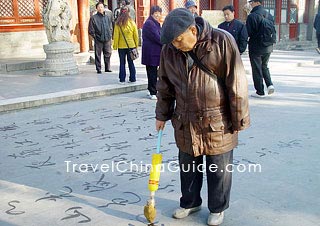 |
| Practice Calligraphy |
Today, although various modern ways have been substituted for the original calligraphy, especially which created with a writing brush, people still love the ancient form and practise it untiringly. During the traditional festivals, propitious couplets are always indispensable decorations each written in a beautiful style.
History
Calligraphy has endured for more than 2,000 years, and evolved into five main ways of writing each with different techniques. Even today, these are still followed and practiced often as a hobby.
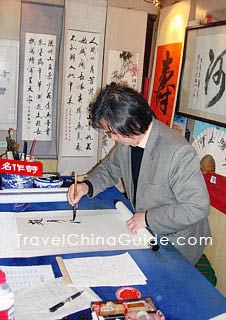 |
| Chinese Calligraphy |
In the Eastern Han Dynasty (25 - 220), people tended to simplify the seal character which had many strokes and created the official script. The new calligraphy appeared to be much neater and delicate, turning the round style into a flat one. When beginning to write a horizontal line, one must let the brush go against the direction of point like a silkworm, and concentrate on stretching steadily, then end up with warp like a swallow's tail. This is one of the characteristics – 'silkworm's head and swallow's tail'.
Just as the name implies, the regular script features its regularity and varies from the flat font to a square one. In Chinese it provides a model that can be followed by calligraphy lovers. It has developed since the late Han Dynasty and is today's most popular and influential writing style. The Sage of Calligraphy, Wang Xizhi led the art of calligraphy to its summit. It is recorded that when a carpenter was asked to engrave the wooden stele where there were characters written by Wang Xizhi, he found the ink had filtered into the wood piece 'three fen' deep (3.3cm or 1.3 inch)! This demonstrated the magnitude of his force and people admired him all the more because of it. The period when regular script thrived most was during the Tang Dynasty (618 – 907), when Yan Zhenqing and Liu Gongquan successively established schools of their own styles noted for their strength and mellowness.
Cursive script has more flexibility, for it only maintains the essence of each character and expresses more personal exertion. Therefore its value lies in appreciation more than practicality. While the running hand makes full use of connecting lines between two strokes it can be regarded as the quickly-written form of regular script. These two seem to be more unrestrained than the previous styles.
Four Treasures of the Study
Writing Brush
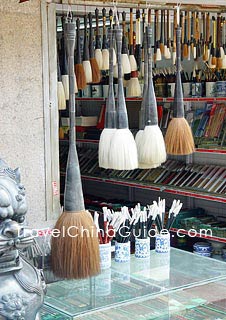 |
| Writing Brushes |
The delicacy gives literators and painters inspiration for creation, and has led to brush shafts being decorated with artistic patterns. One prized example was an ivory-weasel's hair writing brush. On the ivory shaft with the diameter of 0.8 cm, there carved eight figures of the immortals and pavilions concealed seemingly in the clouds. With this in one's hand, the threads of writing would hardly halt.
Ink Stick
Paper
Before the existence of paper, our ancestors utilized knots in cords to record events. They then carved on bone, ivory, tortoise shell and bronzes. For very many years they wrote on pieces of bamboo. There is a story that tells how Confucius was such an avid and diligent reader that he would wear away the strips of ox-leather used to bind the pages of bamboo books together. During the early Han Dynasty wealthy people would write upon white silk but this was beyond the reach of the majority as the cloth was so precious.
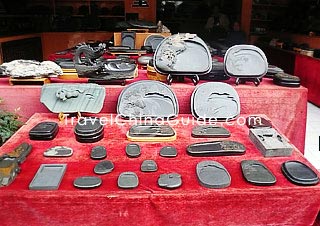 |
| Ink Slabs |
Ink Slab
- Last updated on Aug. 08, 2022 -